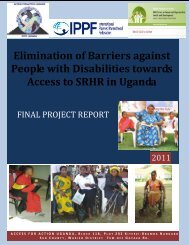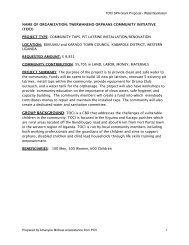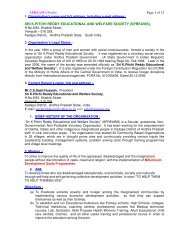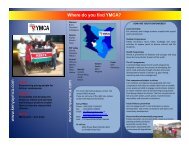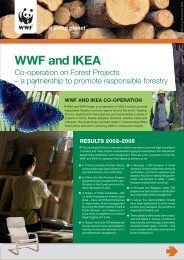BIODIVERSITY RISK & OPPORTUNITY ASSESSMENT - Global Hand
BIODIVERSITY RISK & OPPORTUNITY ASSESSMENT - Global Hand
BIODIVERSITY RISK & OPPORTUNITY ASSESSMENT - Global Hand
Create successful ePaper yourself
Turn your PDF publications into a flip-book with our unique Google optimized e-Paper software.
FLOW CHART OF THE BROA PROCESS<br />
STEPS<br />
PHASE 1- PLANNING &<br />
INFORMATION GATHERING<br />
PHASE 2 – IDENTIFYING, INVESTIGATING &<br />
PRIORITISING <strong>RISK</strong>S & OPPORTUNITIES<br />
PHASE 3 - ACTION & MONITORING<br />
PLANS<br />
1. Planning<br />
▪ Identify BROA Project Team and prepare draft BROA plan, inc. budgets &<br />
timelines for approval<br />
▪ Address training needs<br />
▪ Map stakeholders<br />
▪ Recruit Conservation Partner<br />
2. Desk based information gathering<br />
▪ Gather & collate baseline internal & external data (contacting stakeholders<br />
as required)<br />
▪ Undertake mapping exercise of operations against biodiversity<br />
1. Initial stakeholder engagement & mandatory risk filter<br />
▪ Complete initial stakeholder engagement<br />
▪ Start to identify risks & opportunities<br />
▪ Complete mandatory risk filter<br />
2. Risk & opportunity site surveys<br />
▪ Complete working tables Phase 2 Step 2 with more information on<br />
identified risks & opportunities<br />
▪ Use mapping, working tables & advice from stakeholders to guide focus of<br />
site surveying<br />
▪ Undertake site surveys & stakeholder interviews/workshops to establish<br />
most important risks & opportunities<br />
▪ Update the working tables with evidence collected from Site Surveys<br />
3. Risk & opportunity prioritisation (scoring)<br />
▪ Complete working tables Phase 2, Step 3, prioritising risks & opportunities<br />
for Action & Monitoring Planning<br />
▪ Consult stakeholders on risk & opportunity prioritisation<br />
▪ Produce Executive Summary of results<br />
▪ Present to Top Team for approval<br />
1. Preparing & gaining approval for Action & Monitoring Plans<br />
▪ Complete Action & Monitoring Plan working table producing SMART Plans<br />
for all high & medium risks (and other prioritised) risks & opportunities<br />
▪ Share Plans with key internal and external stakeholders<br />
▪ Gain Top Team sign-off of Action & Monitoring Plans<br />
▪ Escalate dependency issues which cannot be addressed to Centre<br />
2. Implementing Action & Monitoring Plans<br />
▪ Address capacity needs for Plan implementation, including on-going<br />
monitoring<br />
▪ Outsource Plan tasks as necessary<br />
▪ Record Plan progress with evidence in Action & Monitoring working table<br />
▪ Report Plan status in line with BAT review process<br />
▪ Continue ongoing engagement with stakeholders; regular sharing of<br />
Action and Monitoring Plan progress<br />
OUTPUTS & INPUTS<br />
▶ Approved BROA plan with<br />
preparatory steps completed for Phase<br />
2 (e.g. training, budgets & resourcing)<br />
▶ Conservation Partner appointed<br />
▶ Outline map overlaying operational<br />
sites & potential interactions with<br />
biodiversity<br />
▶ Key stakeholder biodiversity issues<br />
identified<br />
▶ Risks identified from mandatory filter<br />
added to risk working table<br />
▶ Completed working tables Phase 2<br />
Step 2 with details and evidence for<br />
risks & opportunities<br />
▶ Completed Working Tables Phase 2<br />
Step 3<br />
▶ Executive Summary<br />
▶ Approved Risks & opportunities for<br />
Action and Monitoring Plans<br />
▶ Completed working tables Phase 3<br />
Step 1<br />
▶ Approved Action & Monitoring Plans<br />
(June)<br />
▶ Greater dependency issues escalated<br />
▶ Actions implemented and<br />
monitoring results recorded in Action<br />
& Monitoring Plan working table<br />
▶ Reports on Action & Monitoring Plan<br />
Progress<br />
3





